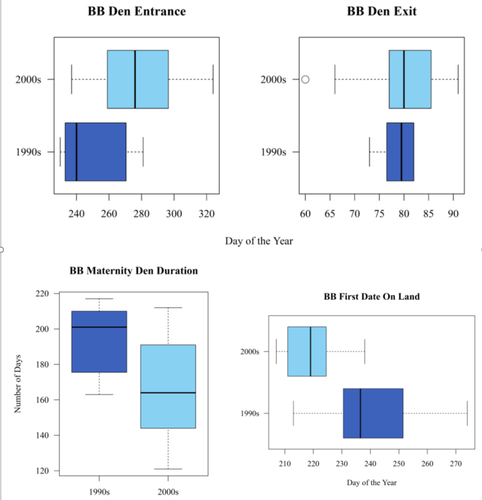Baffin Bugt isbjørne presset af klimaforandringernes effekter Published 26.05.2018

Polar bears in Baffin Bay are going through tough times, and even though they are plentiful in the area, they show signs of stress, and the population may decrease in the future. This is the overall conclusion in three recently published scientific articles by senior scientists Kristin Laidre and Erik Born from the Greenland Institute of Natural Resources with co-authoring scientists from Canada, USA and Norway.
The basis of the articles are polar bear studies and satellite observations conducted during the periods 1991-1997 and 2009-2013. In particular Kristin Laidre, as the driving force behind the scientific articles, has documented how the polar bears in Baffin Bay, as a consequence of the effects of climate change, are under increasing pressure in their natural habitats.

Figure 1. The main area for female polar bears with satellite transmitters in 1991 – 1997 (pink) and 2009-2014 (green). Winter is from November until February, spring from March until July, and summer from August until October. Polar bears from the Baffin Bay population roam in smaller areas than before, their main distribution is further north, and they have less contact with polar bears from neighbouring populations. Source: Laidre K. L., E. W. Born, S. N. Atkinson, Ø. Wiig, L. W. Andersen, N. J. Lunn, M. Dyck, E. V. Regehr, R. McGovern and P. Heagerty. 2018. Range contraction and increasing isolation of a polar bear subpopulation in an era of sea ice loss. Ecology and Evolution. DOI: 10.1002/ece3.3809 – https://onlinelibrary.wiley.com/doi/full/10.1002/ece3.3809
One article describes the reduction of the area that Baffin Bay polar bears inhabit, as well as the increasing isolation of the area’s bears from bears in neighbouring populations (Figure 1).
Another article concerns the changes in the female bears’ behaviour over the course of the last 20 years: Pregnant females leave the sea ice to get to land earlier in summer but hibernate later; they dig out their dens higher in the terrain and stay in them for a shorter period of time (Figure 2).
The third and most recent article demonstrates how the polar bears use areas with less sea ice, stay closer to the mainland and make shorter migrations as the open water season increases (Figure 3).

Figure 2. Time comparison of the periods 1991-1997 (dark blue) and 2009-2014 (light blue) when female polar bears hibernate to give birth (top left), left the den with the cub (top right). Bottom left is the time the females spent in the den. Bottom right is the time when the pregnant female arrived to land after the sea ice melted or summer. The graphs illustrate that the polar bears from Baffin Bay population arrive earlier to the mainland, where the possibility of catching seals is poorer, they hibernate later to give birth, and they spend less time in the dens. Source: Erica Escajedas dissertation at Washington University and Escajeda, E.*, K. L. Laidre, E. W. Born, Ø. Wiig, S. Atkinson, M. Dyck, S. H. Ferguson, N. J. Lunn. 2018. Identifying shifts in maternity den phenology and habitat characteristics of polar bears (Ursus maritimus) in Baffin Bay and Kane Basin. Polar Biology 41(1): 87-100. 10.1007/s00300-017-2172-6 (*graduate student author) – https://link.springer.com/article/10.1007%2Fs00300-017-2172-6
Some of the results have already been included in previous strategic environmental assessments for areas in Disco West in 2013 and the eastern Baffin Bay in 2011, as well as in a report from the Canadian/Greenlandic Polar Bear Commission´s scientific work group in 2016. However, it is the first time that the studies, after a thorough revision process, are published as scientific articles and conveyed to scientists around the world.
The studies and the satellite tracking of the Baffin Bay polar bears were done by scientists from Greenland and Canada, as the two countries share the population. The satellite tracking in 2009-2013 was primarily funded by the Danish Environmental Protection Agency via the DANCEA scheme. The Greenland Government contributed funding from oil companies with exploration licenses in Northwest Greenland.

Figure 3. Changes in number of days with more than 15 % sea ice. The black dots on the map (left) show areas which are less then 300 m deep. The grafs (right) show the number of days per year with more than 15 % sea ice for two selected places. The gray areas show the two periods when the polar bears were equipped with satellite collars. Loss of sea ice has increased along the Greenlandic coast. Source: Laidre K. L., H. Stern, E. W. Born, P. Heagerty, S, Atkinson, Ø. Wiig, N. J. Lunn, E. V. Regehr, R. McGovern, M. Dyck. 2018. Changes in winter and spring resource selection by polar bears Ursus maritimus in Baffin Bay over two decades of sea-ice loss. Endangered Species Research 36:1-14. https://doi.org/10.3354/esr00886
For more information, please contact:
Kristin Laidre, e-mail krla@natur.gl, or Fernando Ugarte, phone +299 36120 or e-mail: feug@natur.gl

